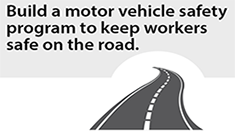Behind the Wheel at Work

Behind the Wheel at Work is a quarterly eNewsletter bringing you the latest news from the NIOSH Center for Motor Vehicle Safety.
Volume 3 Number 4 December 2018
Journey Management 101
A familiar term in the oil and gas industry, “journey management” is an approach that guides how a company manages transportation risk. This concept includes considerations for the need to travel and the safest mode of travel—something that can be applied in any industry and operating environment. Get an overview of journey management in this month’s newsletter. Access previous newsletters.

Think about a time you’ve looked at the week ahead and planned trips to coincide with times and streets with low traffic density. Maybe you combined trips, such as shopping and dropping off/picking up children from school. These are simple examples of journey management in your personal life. The approach to reduce miles driven and exposure to road hazards can be applied in a more systematic way in the workplace.
Definition: Journey management refers to a planned and systematic process of reducing transportation-related risks within a company’s operations.
Objective: Minimize unnecessary trips, distances driven, and the risks associated with necessary trips.
Components:
• A policy that contains site-specific assessments of transportation-related hazards and what steps will be taken to minimize these hazards
• A process to assess the need for trips and seek to eliminate unnecessary trips
• A procedure for managing trips, including safe route planning and minimizing driving and environmental risk and the distances driven in a single trip
Benefits:
• Eliminate unnecessary driving, lessening risk of crash
• Minimize exposure to road traffic hazards
• Reduce fuel costs
• Reduce wear and tear on vehicles
• Reduce liability
• Increase efficiency
The bottom line: journey management has clear safety benefits and cost savings.

The following 7-step process can help guide your organization to add a journey management procedure (JMP) to your road safety program.
Step 1: Adopt journey management (JM) as part of your overall road safety management system by creating a JM policy statement that explains the goals and expectations for its use to reduce crash risk. Determine the standards your JMPs must meet and document those standards in your JM policy. For example, you might decide that each operating location must develop a JMP to suit local conditions. You might also require that supervisors drive regularly-used routes periodically to identify new hazards.
Step 2: Determine necessary driving activities by challenging the need for any trip. Is travel necessary? Is travel by road necessary? Can multiple needs for travel be met in a single trip by combining loads or “chaining” together smaller trips? Is it necessary for my company to do the transporting?
Step 3: Start a risk register that identifies common hazards or conditions that may cause a motor vehicle incident. Review your fleet’s previous incidents and use driver input to help identify hazards and conditions. Here’s how you might organize an entry on winter driving in your risk register:
| Activity | Category | Hazard | Risk |
|---|---|---|---|
| Winter driving | Driver | High levels of sustained alertness needed in extreme driving conditions | Driver fatigue or micro-sleep, leading to a crash |
Step 4: Identify controls to prevent and/or reduce each risk, and add them to the risk register. Primary controls include elimination (foregoing unnecessary travel), substitution (e.g., using a safer mode of transportation), engineering (e.g., requiring new vehicles to be equipped with automatic emergency braking), administrative (e.g., giving stop-work authority if driving is too hazardous), and personal protection (e.g., requiring all vehicle occupants to use seat belts).
Step 5: Create a JMP document and inform workers. The JMP brings the JM policy statement, standards, risk register, and risk controls together in one document. When informing managers, supervisors, and workers of the JMP, emphasize the benefits to safety and productivity as a result of increased efficiency.
Step 6: Manage each trip before, during, and after the journey. Assess risk, monitor risk, and learn about new risks by encouraging drivers to inform you of any new or temporary hazards.
Step 7: Review the JMP’s success, and keep in mind that the operating environment is constantly changing. Tracking incidents can measure the success of a JMP and signal a need for adjustments.
The bottom line: A thoughtfully designed journey management procedure can enhance your road safety program.
Pratt, Retzer, and Tate [2014]. Reducing road risk using journey management. Proceedings of the ASSE Professional Development Conference.

Reducing the amount of driving workers do is the most effective way to prevent motor vehicle crashes. If you don’t already follow journey management practices, there are simple steps you can take to get started today.
Use the following tips to decide whether work can be done without driving and how to keep workers safe if driving is necessary.
- Before assigning a worker to drive, consider these questions:
- Is travel really necessary? Consider whether work can be done by phone, video-, or web-conferencing.
- Is driving necessary? Consider safer forms of transportation such as air or rail.
- If workers must drive:
- Assess risks on regularly-traveled routes and make this information available to drivers and supervisors. Talk to local contacts about current road conditions and road closures, and advise drivers before they travel.
- If other workers are travelling to the same location, consider having them drive together.
- Reduce exposure to traffic hazards and save fuel by combining trips and loads.
- Set work schedules that allow workers to obey speed limits and follow applicable rules such as hours-of-service regulations.
- Set policies that limit driving at night and during inclement weather, and empower drivers to stop driving if they are too tired.
- Remind workers:
- Buckle up: every trip, every person. It only takes a second.
- Do not drive if you are fatigued. Stop and take breaks as needed.
- Map out safe routes in advance and check road conditions.
- Keep alert and aware of your surroundings. Other drivers may be impaired, fatigued, or rushing to reach their destinations.
- Tell your supervisor when you expect to arrive at a destination, and contact your supervisor to confirm your arrival.
The bottom line: Get your employees (your most important asset) from point A to point B in the safest way possible.
Working nonstandard shifts can have adverse health and safety consequences for workers, their families, and the general public. Join NIOSH for the Working Hours, Sleep & Fatigue: Meeting the Needs of the American Workers and Employers Forum on September 13–14, 2019, in Coeur d’Alene, Idaho. Learn about research gaps and effective countermeasures related to working hours, sleep, and fatigue among U.S. workers and employers. Everyone interested in worker safety is invited to come discuss this important topic.

Journey management is best applied as part of a larger program. Learn 4 steps to build a motor vehicle safety program. The new animated image (GIF) from NIOSH will play in presentation mode in PowerPoint, on Twitter, and on electronic message boards.
Questions? Comments? Email kur4@cdc.gov.

What motor vehicle safety topics do you want to read about? Tweet or email us to share your thoughts.
Enter your email address to receive research updates, links to motor vehicle safety resources, practical tips on workplace driving, and news about upcoming events.

